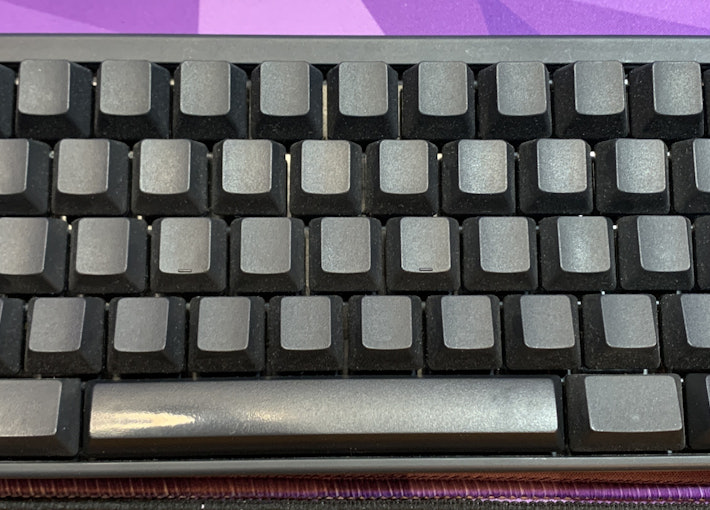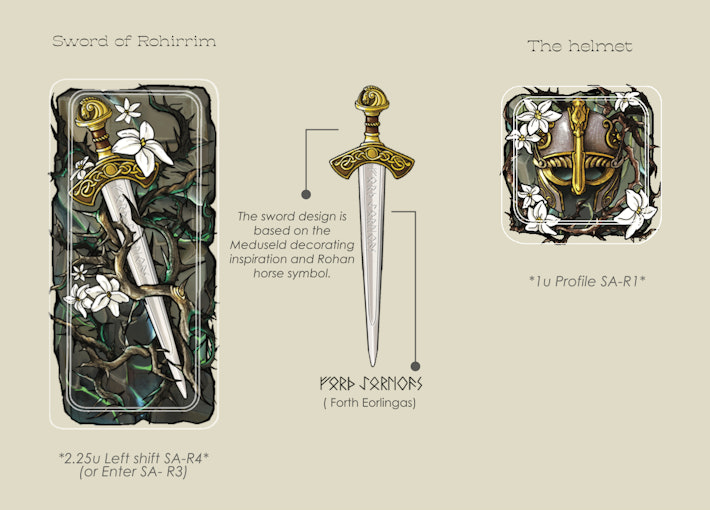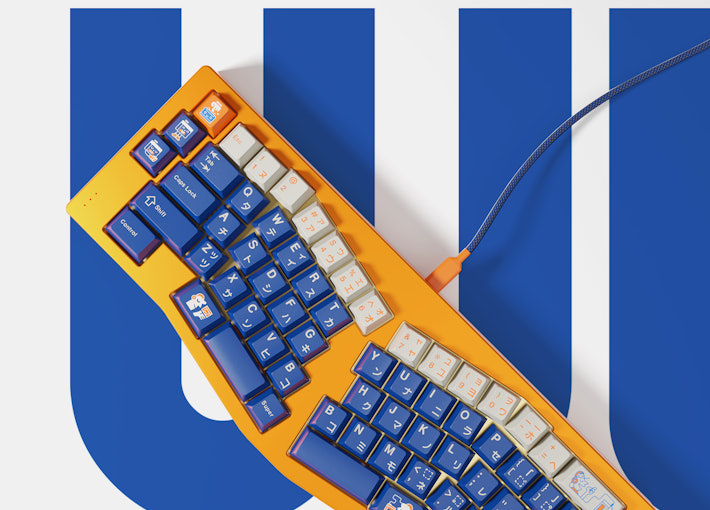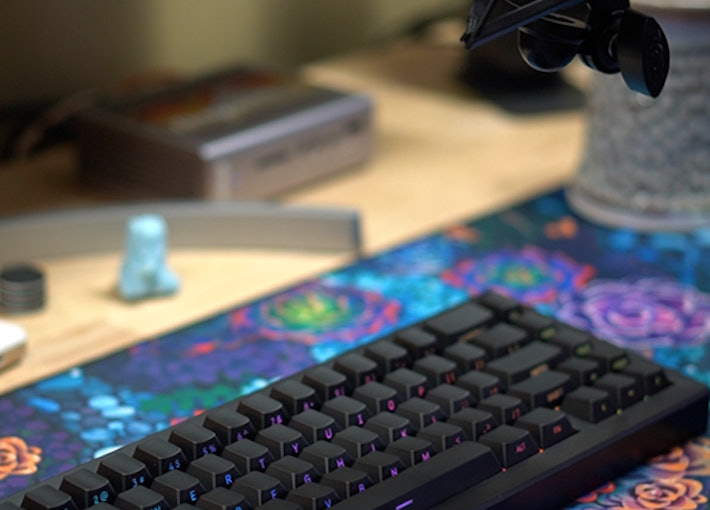Click to view our Accessibility Statement or contact us with accessibility-related questions





















Mechanical Keyboards

Drop+MechKeys
4435
Sep 10, 2024
Meet Captain Sterling, Dragon Darts Designer and Aesthetic Aficionado
We're here today to share an interview with our latest collaboration designer, Captain Sterling. You've probably seen him around the community before, having designed a few sets over the years as well as being one of the more prominent social media creators in the space (and, frankly, taking some of the most stunning keyboard photos you'll come across).
With that in mind, we are beyond excited to be able to feature an interview with Captain Sterling—thank you so much for taking the time to answer our questions and share so much about your own life with us all!
We’d love to hear a little bit about yourself and your history - relevant to mech keys or not. Where are you from, what is your “day job”, what are your other hobbies and interests aside from keyboards?
I was born and raised in Texas. I’m married and have a lovely, supporting family. I am a full time Product and Wedding Photographer who pursues Content Creation on the side. I also love to play video games, most...

Drop+MechKeys
4435
Aug 13, 2024
Meet balance, Bim's creator
DCX Bim is launching today, so to help celebrate the occasion we have called upon the creator of Bim to peek out from behind the curtain and share a bit about himself and his design process. Welcome balance, and thank you in advance for taking the time to answer our questions!
With that, let’s take a dive into the mind of balance!
How did you get into mechanical keyboards as a hobby? Was there any particular event that caused you to seek it out, or was it a slow burn over time?
I got into mechanical keyboards through one of my friends as he was really fond of keyboards and 3d design.
What caused you to take the next step in the hobby, moving from enjoying keyboards to designing keysets and taking on more of a “making” role?
Actually, I was really interested in designing and 3d modelling and I have discovered people who designed keycaps. While doing this, I fell more in love with the hobby and designs around them, influencing me to make my first ever custom keyboard....

HoffmanMyster
3230
Jul 30, 2024
Mech Keys in the Windy City
Having just returned from That Windy City Keeb Meet (a long-winded way of saying "The Chicago Meetup"), still recovering from the whirlwind that is a meetup weekend, I wanted to quickly put keeb to talk post (as they say) and share a bit about the event.
Drop's vendor table at That Windy City Keeb Meet 2024
First off, if I ran into you at the meetup, it was great to meet you! I had a blast (as always) getting to know and reconnect with keyboard fanatics from all around the country. It never ceases to amaze me how many overlapping and interconnected hobbies we all share—certainly helps keep the conversations interesting as we veer off into retro gaming, photography, music, and anything else that comes up.
All eyes on the announcement podium for giveaways 🫡
We were joined at the vendor tables by Sneakbox, Switch Oddities, and Tactile Zine—all run by amazing individuals. I wish I had taken pictures of all of their setups to share here. The only one I have is of...

Drop+MechKeys
4435
Jul 12, 2024
Introducing DCX Bim
We could all use a personal assistant. Why not make that personal assistant a robot with a bright personality? That’s the inspiration behind Bim: a colorful robot-turned-DCX-keycap set, designed by Balance. Because our fingertips could always use another friend, too.
Bim will now show you around.
Bim welcomed you!
Bim is opening Settings...
→ Settings
→ General
→ Kits (Partial)
Base Kit
Novelties Kit
Bim closed kits
Bim opened Settings again...
→ Settings
→ General
→ Renders
Renders
Info: 29 July | Saturday | Board: FROG TKL BY GEONWORKS
Info: 26 July | Wednesday | Board: Amano by h40.io
Bim closed renders
Bim is now exhausted and wants to go to sleep.
Bim thanks you for checking the IC.
Bim says "See you later for more updates!"
Bim Status: OFF
ThereminGoatMK
458
Jun 26, 2024
Long Stem Poles? In My Switches???
Figure 1: Are these even long pole? I don't know, but they're really serving 'long pole vibes'. Something tells me I should probably be a little more rigorous about them than that though..
Honestly, I’m a tad bit compelled to kick off this article by once again hammering on the meme that everyone newer to the hobby loves to repeat in that “all linears are basically the same”. While my aptly named last article from Drop titled ‘Not All Linears Are The Same!’ likely did a good enough job of dissuading most readers of that age old falsehood, this one may help put it to rest for the remaining few of you who weren’t so convinced. Don’t worry to all of you reading this who don’t care that much for linear switches, either, as the idea of ‘long pole’ switches can also apply to tactiles too! Once an odd design quirk developed to help emphasize sharp, forceful, and pointed bottoming out sensations in BSUN and Tecsee switches back in 2020, ‘long stem poles’ have since morphed into a...

Drop+MechKeys
4435
Jun 25, 2024
Introducing Bees.Keys, designer duo behind DCD Hundred Acres
With the launch of DCD Hundred Acres imminently on the horizon, we wanted to introduce the designers of this fantastic set to the Drop community! Welcome Bees.Keys, and thank you both for so generously giving us your time to chat about yourselves, your process, and the Hundred Acres keycap set! For those unfamiliar, Bees.Keys is a team made up of Beesley and Cthalupa - both fantastic designers and a joy to speak with.
Without further ado, let's get things started!
Tell us a bit about yourself and your history - relevant to mech keys or not. Where are you from, what is your “day job”, what are your other hobbies and interests aside from keyboards?
[Beesley]
I’m from the UK, and my day job is producing marketing renders for mechanical keyboards and keycaps. I have always had a passion for CGI since I was kid, getting a subscription to 3D World magazine for my 10th birthday.
Other hobbies? What are other hobbies? I’m lucky enough to enjoy doing something for work so much...
ThereminGoatMK
458
May 29, 2024
Not All Linears Are The Same!
Figure 1: Not even all of these (mostly) KTT-made linears are the same!
After all of my years of collecting, reviewing, and obsessing over switches, I can say with certainty that linear switches are the most misunderstood of all of the switch types. No, I’m not talking about mechanically either, as all of the claims of them “just going straight up and down” are somewhat kind of true. (Not too much though, don’t get that excited.) The part that is often misunderstood, though, is usually in what is being implied when people say that these switches just go straight up and down – “All linears might as well be the same.” If the title of this article didn’t make that obvious enough to you, I find that sort of idea to be completely and utterly wrong. The people who make these implications wouldn’t say that a Cherry MX Black is the same as a Novelkeys Cream switch? They also certainly wouldn’t ever claim that every Gateron-made linear is the same as every fancy TTC one out there...

Drop+MechKeys
4435
May 21, 2024
Drop + Bees.Keys DCD Hundred Acres Keycap Set
Winnie-the-Pooh - a story, characters, and setting loved by many across the globe. Most of us grew up with at least some exposure to this lovable bear and his woodland friends. Personally, the Hundred Acre Wood takes me back to a simpler time in life—a time of whimsy and wonder.
Bees.Keys shares this appreciation and affection for Pooh Bear and friends, going as far as designing a keycap set around the characters and themes. One look at the set shows their dedication and attention to detail. From the font to period-accurate depictions of characters to elaborate desk mat designs, this is as faithful a tribute as you’ll find.
We hope you’ll join us on this nostalgic journey through the Hundred Acre Wood when the set launches later this month. Hit Request to be notified!

storyboardtech
489
May 15, 2024
Building Tribute Boards: the art of imitation
“Anne Marie? Do the interns get Glocks?” asks Steve Zissou (Bill Murray) in Wes Anderson’s classic The Life Aquatic with Steve Zissou. “No” she replies without pausing from looking up from sunbathing… “they all share one.”
If you’re new to director Wes Anderson and his collection of artsy, charming, and sometimes problematic but otherwise entertaining films, The Life Aquatic is a good place to start. Not because it’s his best work (The Royal Tenenbaums) or even his most approachable (The Fantastic Mr. Fox) … but because it is all of the things I described above and is a perfect example of what a Wes Anderson movie is. The actors, who make up his all-star casts are reduced (if that term can be used this way) into extensions of Anderson’s creative mind and play their parts to perfection. The plot is funny and also tragic, the music in the movie is completely unique and also instantly recognizable (Portuguese covers of David Bowie songs) and the movie blends dialogue and...
cobertt
36
May 7, 2024
State of the Hobby 2024
A brief reflection and look at how far our community has come since joining.
I’ve been in the mechanical keyboard hobby for a very long time. It started as a high school student’s search for a keyboard for writing novels back in the 2008-2009 school year. I thought I wanted to be an author and I felt I needed a keyboard that I could sit down to at my desk and just write. After researching, joining forums, and saving money, I made my first purchase in the hobby, a blank black Happy Hacking Keyboard Professional 2. I still own this keyboard and while it is heavily modded now, it remains one of my all-time favorites.
My HHKB Pro2 with MitchCapped Accents
Many people would have stopped there, but keyboards became a hobby. I enjoyed learning about them, and early on, I enjoyed hunting for them in thrift shops. I would dig through bins at Goodwill and Salvation Army while popping keycaps off with paperclips looking for mechanical switches. I searched for a birthday Model M...

dovenyi
77
Apr 30, 2024
What is SpaceFN and why you should give it a try
The SpaceFN concept - setting up your space key as a layer switch when held - is probably one of the most useful tweaks in the keyboard hobby. Let me explain how it works.
My SpaceFN article on kbd.news made some rounds recently - quite surprisingly given the age of this concept. This piece you're reading is a condensed version of the full post. If you're left with unanswered questions, you'll most likely find the info you're looking for in the original write-up.
On my imaginary top list of the most useful keyboard features, tweaks and hacks, SpaceFN would deserve a podium finish for sure. But what makes it so special?
In short: SpaceFN is easy to implement, easy to learn, costs nothing, can be used with any keyboard, and can improve your productivity instantly.
I will list its benefits below, but can state right at this point that the SpaceFN concept, setting up your space key as a layer switch when held, is clearly one of the most useful tweaks in the keyboard hobby....

dvorcol
5402
Apr 23, 2024
Support for Alternative Layouts
This is a summary of how alternative layouts have been supported by kits such as Colevrak and Homing. It is not a discussion of alt layout performance and development, but if that interests you I highly recommend starting with Pascal Getreuer’s A guide to alt keyboard layouts (why, how, which one?). It’s a concise and comprehensive overview with links to some great sites that go deeper. He also has a separate Links about keyboards page. The Keyboard layouts doc he recommends explains layout goals and metrics in detail, summarizing the alt layouts discussed here as well as more than one hundred others.
Sculpted-profile
The majority of custom keycap sets are sculpted-profile (Cherry, SA, MT3, KAT, etc. - more on profiles generally here) so let’s start there. Because each row has a unique keycap shape, alt layouts require a unique keycap for each legend that moves off its QWERTY row.
At first there were two
The Dvorak layout was patented in 1936 by August Dvorak & William L....
ThereminGoatMK
458
Apr 17, 2024
Do I Need to Lube My Keyboard Switches?
Figure 1: Sometime around here is a good time to ask that question...
If you’re new to the mechanical keyboard hobby, I have no doubt that planning your first keyboard build is a bit of a daunting task. To be entirely honest with you, it’s only a tiny bit less daunting for your second or even third keyboard builds should you stay around a little while longer. You’ve got the keyboard itself to worry about, stabilizers, keycaps, and even switches on top of all of the intangible marks you want your dream keyboard to hit. Switches are especially daunting right out of the gate as there’s just so many options out there to pick from – each with their own unique specifications, manufacturers, and more. Yet, in spite of all of these differences between switches, time and time again I find people always asking about lubing switches as one of their chief concerns when it comes to picking some up. With countless numbers of content creators talking about lubing switches, its no...

HoffmanMyster
3230
Apr 10, 2024
From Art to Artisan
Before launching any product, there are many designs, concepts, and ideas that pass between teams before arriving at a final design which makes its way to your computer screen and, eventually, desk. This is no more true than when considering possibly the most "art"-forward aspect of the mechanical keyboard hobby—artisan keycaps. It should be obvious that a lot of planning and artistry goes into crafting these literal pieces of art. We don't often get a chance to see behind the curtain, though. So, let's take a closer look at the upcoming Drop + Dwarf Factory Lord of the Rings Rohan Artisan Keycaps.
Before any resin is spilled, Middle Earth (the entity that licenses the Lord of the Rings IP) needs to approve the concepts based on concept art provided by Dwarf Factory. We connect with DF to coordinate on the topic and subject matter—in this particular case, additional Rohan-themed designs—to be sure that the concepts match with overall direction, whether that be pairing up with a...

Drop+MechKeys
4435
Apr 10, 2024
Mr. Bingo's Design Process and Inspiration
If you haven't seen the first part of our interview series with Mr. Bingo, be sure to check that out for an introduction to the designer himself. We're picking things up here with part two, where Mr. Bingo shares some of his design process and how he draws inspiration for his designs!
Before we dive in—we want to express another huge thank you to Mr. Bingo for taking the time to answer all of our questions here. It's always fascinating to get a peek behind the curtain and we're very appreciative for the opportunity.
Do you have a process for gathering your potential ideas, and culling down to workable concepts that you select designs to move forward with and take to the community? Would you be able to share a bit about what goes into those decisions?
I feel that I am a designer who likes to have physical things and not digital. So when it comes to making a set and already have the idea, I look for things physically, for example, in the matcha set, I did a lot of...

Drop+MechKeys
4435
Apr 10, 2024
DCX Dragon Darts - Big Keycaps from Pocket-Sized Inspiration
You might know Captain Sterling best from his photography and content creation work, but he's also no stranger to keycap design. In fact, he has designed at least three keycap sets in the past couple of years—KBM Nekoccino, kfaPBT Forest Watcher, and WS Entwined Flowers.
Most recently, Captain Sterling has been working with us on his latest design project, DCX Dragon Darts. This keycap set is inspired by a childhood love of Pokémon, harkening back to a simpler time in life when playing games with friends every afternoon was not only possible, but quite possibly the biggest event of the day.
Dragon Darts pulls inspiration from a relatively recent Pokémon, Dragapult. Dragapult is a Ghost/Dragon type 'Mon, which is "arguably one of the coolest type combinations ever" -Captain Sterling.
When he's not clacking away on a keyboard, Sterling is busy with a full-time career as a photographer—which explains the stellar quality of his photos. With an eye for all...

HoffmanMyster
3230
Apr 9, 2024
DCX vs DCD vs DCL - Drop’s Keycap Profiles Explained
We’ve covered the basics of keycap profiles before—spherical/cylindrical, sculpted/uniform, etc. One thing that has come up more and more over the years as we’ve expanded our portfolio of offerings here at Drop is the distinction between some of our similar profiles. Specifically, what is the actual difference between DCX, DCD, and DCL?
Cylindrical Profiles
To recap the previous article on the topic, one of the most basic ways to separate various keycap profiles is by shape (cylindrical, spherical, or flat). DCX, DCD, and DCL are all cylindrical profiles.
The most famous cylindrical profile is Cherry profile, as defined by the original manufacturer of the keycaps—Cherry. GMK now owns those tools, and as such, only they can technically claim to produce “Cherry” profile keycaps. Similar keycap profiles are often called Cherry profile colloquially, but are in actuality slightly different. For the sake of not splitting hairs, all of the cylindrical profiles discussed here are...

Drop+MechKeys
4435
Apr 9, 2024
Introducing Mr. Bingo, Retro-Inspired Designer
It is with great pleasure that we are able to formally introduce Mr. Bingo by way of an interview! Thank you so much for taking the time to answer all of our questions and allow us to peer inside your process a bit.
For those of you who aren't familiar with Mr. Bingo's past work yet, he's the brains behind GMK Cream Matcha and GMK Cubed, as well as many renders in support of other projects across the hobby.
He is of course also the designer behind DCD WLK-MN, his latest project inspired by a love of retro gadgets. So, without further ado, let's get to know Mr. Bingo!
We’d love to hear a little bit about yourself and your history - relevant to mech keys or not. Where are you from, what is your “day job”, what are your other hobbies and interests aside from keyboards?
Hey, well my day job is to design and do renders for a company that makes keyboards and gaming products. So I live from this hobby everyday! I also have other small hobbies that I'm just starting right...
cobertt
36
Apr 2, 2024
3 or 5? How many pins does your switch really need?
One of the oldest questions, albeit one you don’t see very often anymore, is about 3-pin and 5-pin MX switches. Early in the custom switch scene, budding enthusiasts would need to determine whether their keyboard needs 3-pin or 5-pin switches. Today, the question doesn’t appear as often as it used to, but it is still important to know the difference and when one is a better choice.
The difference between these two types of switches is in the name, the number of pins. As seen in the pictures below, 3-pin switches have two metal legs for the contact leaves and registering of switch presses as well as the stem pole. These switches were traditionally called plate mount switches, as they relied on the plate to align the switches on the PCB. 5-pin switches have the same contact pins and stem pole but are also accompanied by two additional alignment pins on the left and right of the stem pole. These were called PCB mount switches, as they could be used without plates as the PCBs would...
ThereminGoatMK
458
Mar 27, 2024
Mechanical Keyboard Sound Isn't That Simple
Figure 1: I couldn't think of a more literal way to represent this article if I tried...
Looking back just a few years ago, there’s no doubt that the huge influx of people that joined the hobby at the peak of the COVID pandemic were drawn to keyboards by way of YouTube, TikTok, and other audio-visual content platforms. Even as the output from these content creators has waned in recent months, their collective impact and legacy on the keyboard hobby is rather firmly etched in the history books. As a result of all of their sound tests, build logs, and opinion videos, the message is clear to any new person joining the hobby: mechanical keyboards are all about the sound. Thock this, clack that. Whether it’s keyboards, keycaps, or even singular switches, seemingly everyone new to the hobby meticulously pores over each component of their keyboard not in an attempt to figure out how it will feel in hand, but how it will sound as they’re furiously grinding their way out from...

































